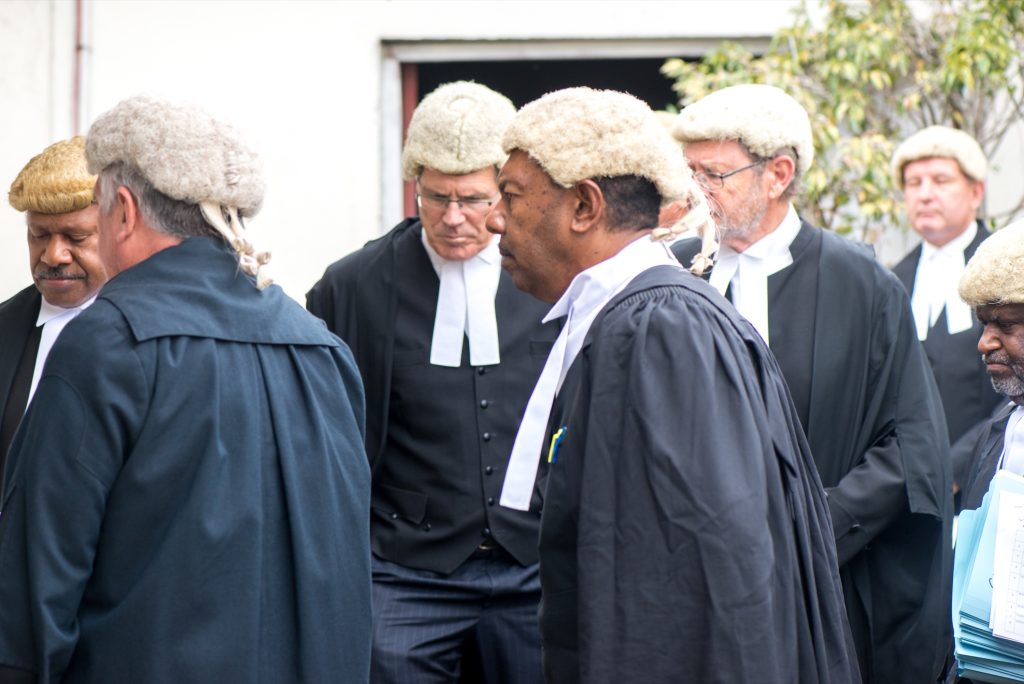
Once again PacLII has proved itself an invaluable public legal resource by making all Appeal Court judgments available online within 24 hours of their being handed down.
The decision that has fixated everyone’s attention is Criminal Appeal Case 12 of 2015, titled Kalosil v Public Prosecutor. The judgment brings together six different appeals by the imprisoned MPs in this year’s bribery case.
The appeals on all sentences and convictions were dismissed.
The decision was written by a panel of four judges, led by Chief Justice Vincent Lunabek. It first considered the core facts of the case—that shortly before 21 October, a Hong Kong resident named Fong Man Kelvin sent half a million US dollars to the Pacific International Trust Company, or Pitco, as it’s known locally.
Shortly afterward, the equivalent of US$ 350,000 was transferred to Moana Carcasses, who was then leader of the Opposition. Much of that money was subsequently distributed in Vt1 million chunks to numerous MPs.
Before another month had passed, a motion of No Confidence was tabled in Parliament, featuring the signatures of all the appellants.
From there, a number of items of contested evidence were considered. Among the most hotly disputed was the testimony of a number of MPs who swore that they had received money either from Moana or from Tony Nari, acting as “a deputy to Mr Kalosil, helping him find recruits to receive the bribes”.
MP Richard Mera became the source of much attention when he testified that he had, metaphorically speaking, flushed the money he received down the toilet.
The appellants claimed that in their testimony, Mr Mera and others had effectively announced themselves as accomplices in the crime, and therefore of their motivation for giving evidence should come into question. They argued that their honesty and reliability were dubious at best, and likely valueless.
The judges accepted that “accomplices may have their own personal motive to deceive the Court”. They further stated that “it would have been good practice for the Judge to have articulated a warning to herself in her judgment…”, but concluded that when all was said and done, Mary Sey demonstrated that she was “aware of the nuances of the evidence” and that she was not blind to the MPs’ possible motivation to deceive.
Besides, the judges stated, the defending counsel never asked Justice Sey to caution herself during the trial.
This was not the only criticism aimed at Mary Sey in the appeals. The appellants argued that she had “misdirected herself on the onus of proof, her ability to find inferences, and her ability to consider the lack of evidence” when the defendants in the case declined to testify in their own defence.
The judges were dismissive of this argument: “The Judge in her reasons carefully set out the onus and standard of proof. She gave herself an orthodox direction on inferences, noting that while the elements of charges have to be proven beyond reasonable doubt, in a circumstantial case the facts relied on in combination to prove the element only have to be proven on the balance of probabilities….”
They also supported Justice Sey on the issue of whether the failure of all of the appellants to testify could actually weigh against them: “While guilt must not be inferred from silence, we have no doubt that a Judge can draw inferences from the failure of an accused to exercise the right to give evidence, when there are proven facts which on an objective examination and in the absence of an explanation are supportive of guilt. If an explanation is required and should be in the accused’s knowledge, the failure to provide that explanation cannot be ignored.”
Some of the appellants argued that the advice to the defendants in the bribery trial to remain silent was tantamount to incompetence by the lawyers representing them, and that this should at least be grounds for a retrial.
This argument was rejected by the Appeals Court. The decision not to testify was a tactical one, they said, and “we can see why given the well known possible consequences of an accused going into the witness box.”
They said that allowing an unsuccessful tactic to provide grounds to revisit the entire case would subvert the judicial process, effectively allowing the defendants to keep trying until they found a winning play.
Finally, and most telling, they weighed in on Justice Fatiaki’s ruling that the Leadership Code charges could not be pursued. Without being asked to do so, they offered their opinion that he erred in his decision, and that the Leadership Code charges should have stood. They also agreed with Mary Sey that Justice Fatiaki’s judgment did not bind her in any way.
Although she was legally entitled to ignore the decision, “She did not do so. To adjourn them was to raise the possibility of double jeopardy.”
In any event, the Public Prosecutor asked to have the Leadership Code charges dismissed, because “the prosecutor could proceed under [sections] 41–42 of the Leadership Code Act seeking an order for dismissal of each of the appellants from office.”
In short, it’s possible that the Leadership Code may yet be invoked.
Finally, the judges found that Mary Sey was sparing, if anything, with her sentences.
“Given [Moana Carcasses’] high position, multiple offending, and the amount of money involved, a starting point of six or seven years could have been justified.”
The Appeals Court panel reviewed submissions concerning the health of some of the appellants, but did not find the material persuasive. Appeals against sentences were all dismissed.
